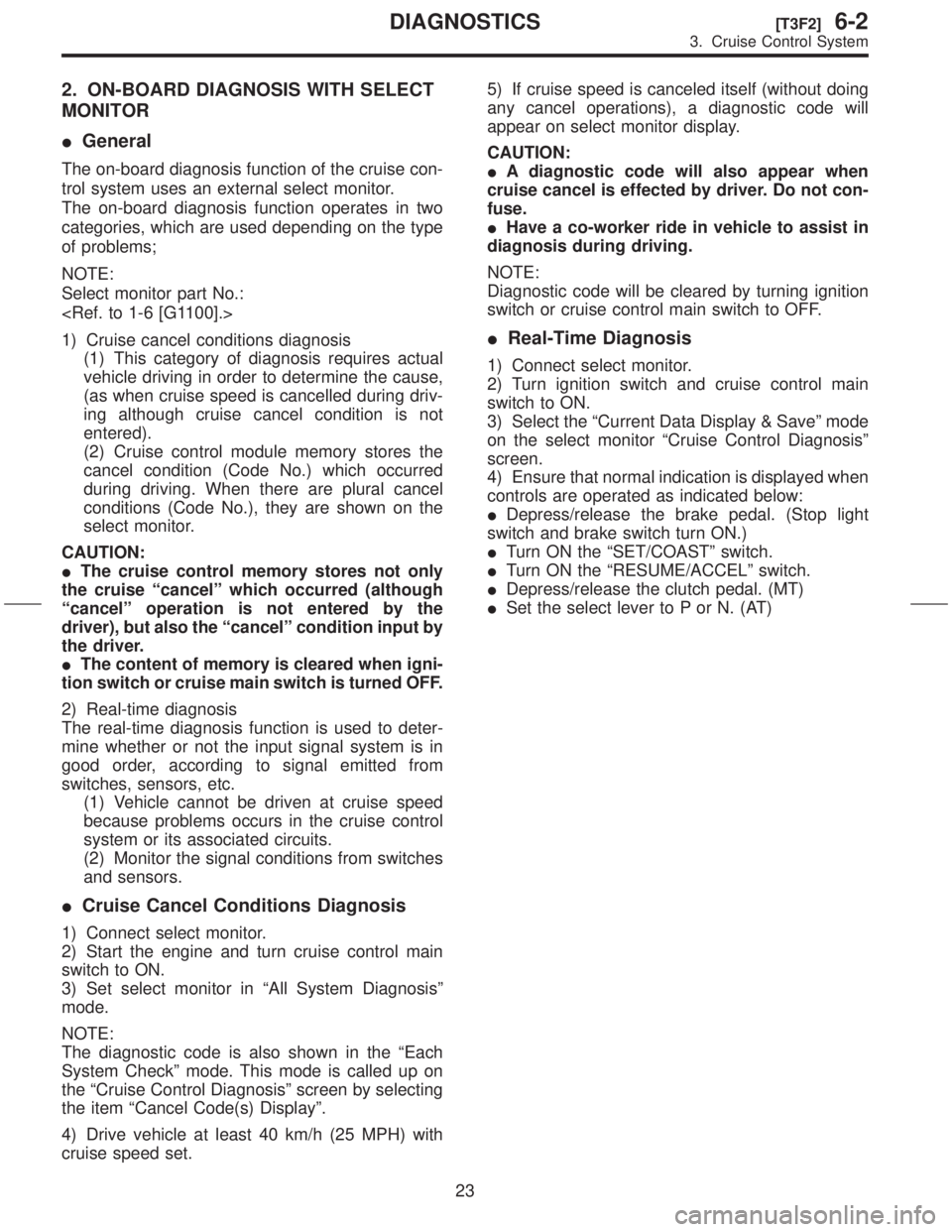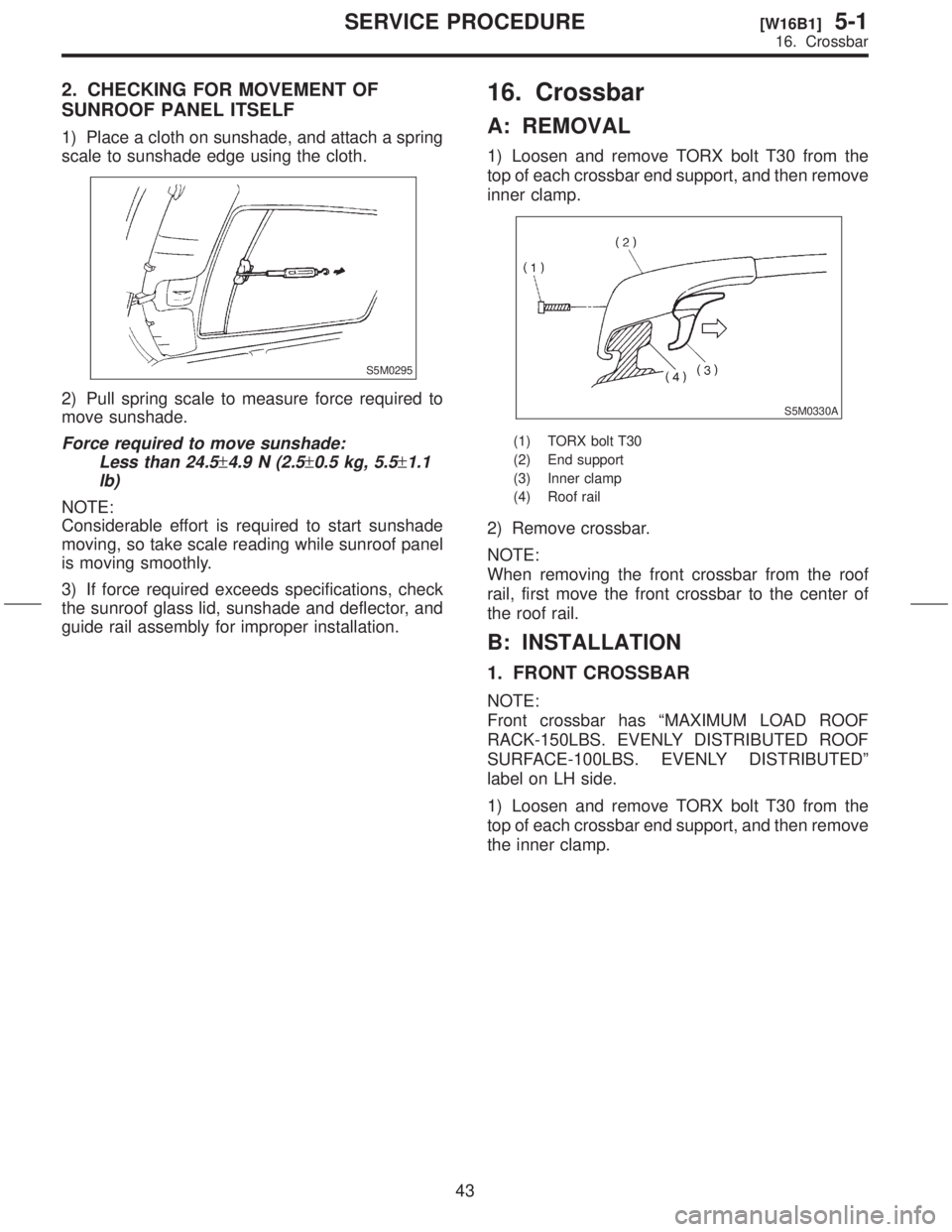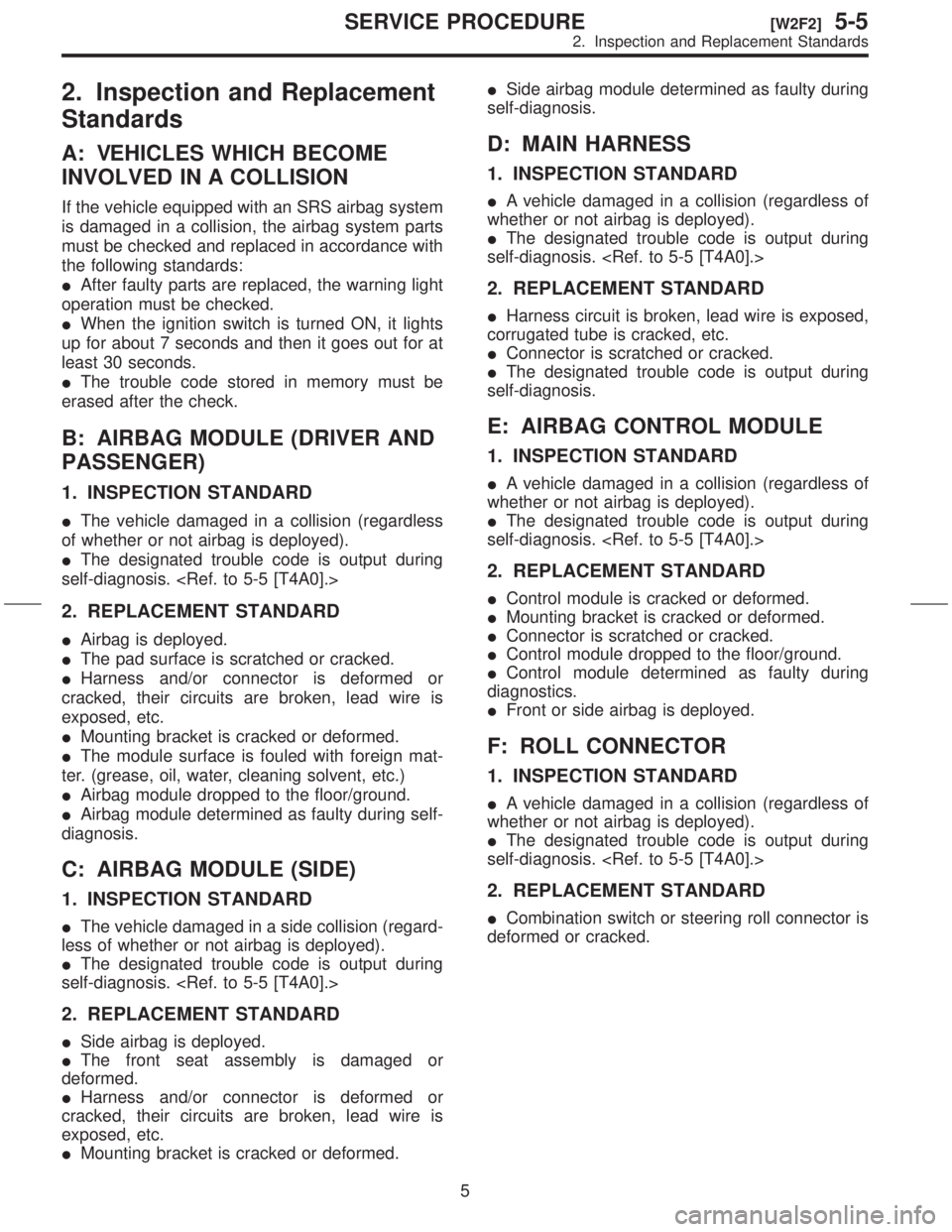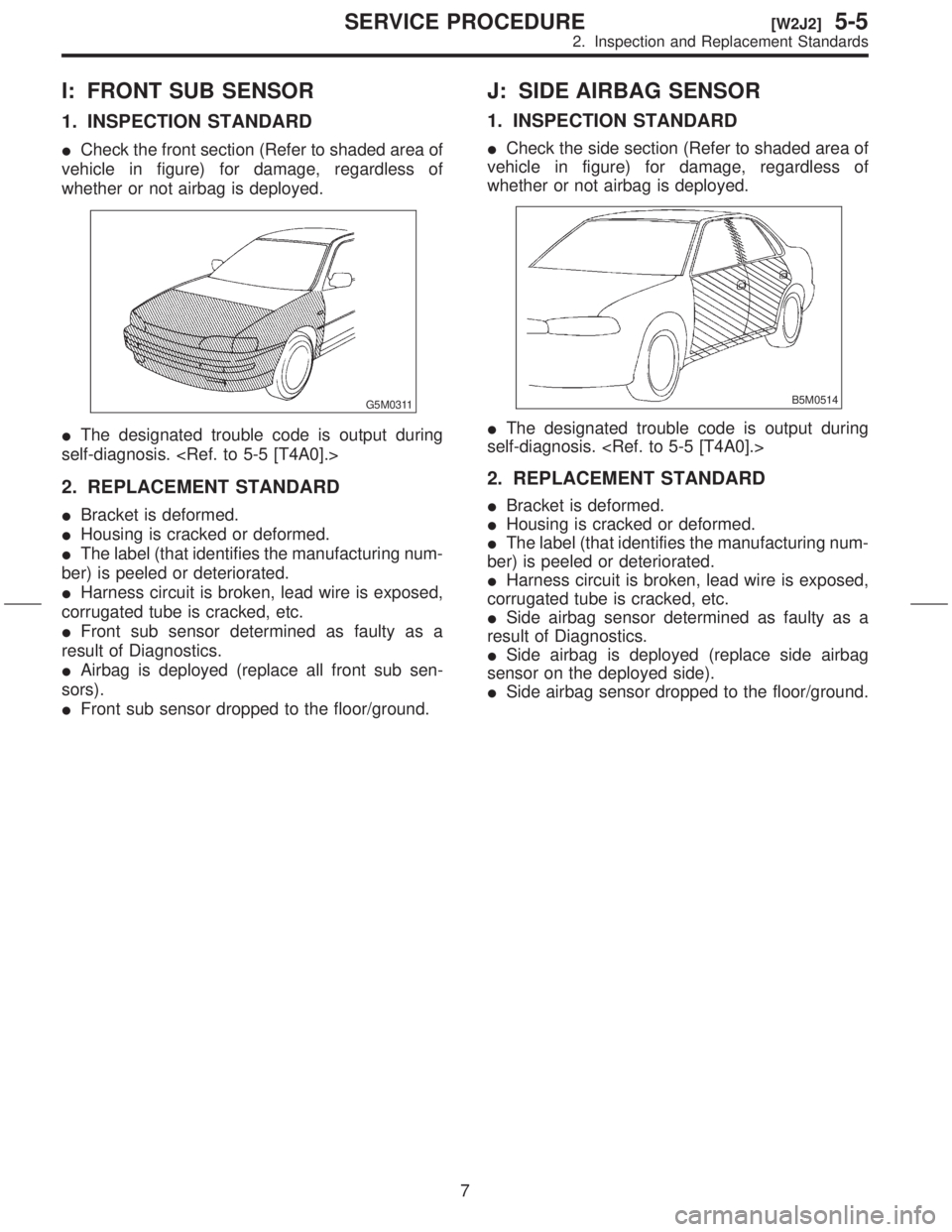1999 SUBARU FORESTER Self check
[x] Cancel search: Self checkPage 85 of 345

2. ON-BOARD DIAGNOSIS WITH SELECT
MONITOR
IGeneral
The on-board diagnosis function of the cruise con-
trol system uses an external select monitor.
The on-board diagnosis function operates in two
categories, which are used depending on the type
of problems;
NOTE:
Select monitor part No.:
1) Cruise cancel conditions diagnosis
(1) This category of diagnosis requires actual
vehicle driving in order to determine the cause,
(as when cruise speed is cancelled during driv-
ing although cruise cancel condition is not
entered).
(2) Cruise control module memory stores the
cancel condition (Code No.) which occurred
during driving. When there are plural cancel
conditions (Code No.), they are shown on the
select monitor.
CAUTION:
IThe cruise control memory stores not only
the cruise ªcancelº which occurred (although
ªcancelº operation is not entered by the
driver), but also the ªcancelº condition input by
the driver.
IThe content of memory is cleared when igni-
tion switch or cruise main switch is turned OFF.
2) Real-time diagnosis
The real-time diagnosis function is used to deter-
mine whether or not the input signal system is in
good order, according to signal emitted from
switches, sensors, etc.
(1) Vehicle cannot be driven at cruise speed
because problems occurs in the cruise control
system or its associated circuits.
(2) Monitor the signal conditions from switches
and sensors.
ICruise Cancel Conditions Diagnosis
1) Connect select monitor.
2) Start the engine and turn cruise control main
switch to ON.
3) Set select monitor in ªAll System Diagnosisº
mode.
NOTE:
The diagnostic code is also shown in the ªEach
System Checkº mode. This mode is called up on
the ªCruise Control Diagnosisº screen by selecting
the item ªCancel Code(s) Displayº.
4) Drive vehicle at least 40 km/h (25 MPH) with
cruise speed set.5) If cruise speed is canceled itself (without doing
any cancel operations), a diagnostic code will
appear on select monitor display.
CAUTION:
IA diagnostic code will also appear when
cruise cancel is effected by driver. Do not con-
fuse.
IHave a co-worker ride in vehicle to assist in
diagnosis during driving.
NOTE:
Diagnostic code will be cleared by turning ignition
switch or cruise control main switch to OFF.
IReal-Time Diagnosis
1) Connect select monitor.
2) Turn ignition switch and cruise control main
switch to ON.
3) Select the ªCurrent Data Display & Saveº mode
on the select monitor ªCruise Control Diagnosisº
screen.
4) Ensure that normal indication is displayed when
controls are operated as indicated below:
IDepress/release the brake pedal. (Stop light
switch and brake switch turn ON.)
ITurn ON the ªSET/COASTº switch.
ITurn ON the ªRESUME/ACCELº switch.
IDepress/release the clutch pedal. (MT)
ISet the select lever to P or N. (AT)
23
[T3F2]6-2DIAGNOSTICS
3. Cruise Control System
Page 205 of 345

2. CHECKING FOR MOVEMENT OF
SUNROOF PANEL ITSELF
1) Place a cloth on sunshade, and attach a spring
scale to sunshade edge using the cloth.
S5M0295
2) Pull spring scale to measure force required to
move sunshade.
Force required to move sunshade:
Less than 24.5
±4.9 N (2.5±0.5 kg, 5.5±1.1
lb)
NOTE:
Considerable effort is required to start sunshade
moving, so take scale reading while sunroof panel
is moving smoothly.
3) If force required exceeds specifications, check
the sunroof glass lid, sunshade and deflector, and
guide rail assembly for improper installation.
16. Crossbar
A: REMOVAL
1) Loosen and remove TORX bolt T30 from the
top of each crossbar end support, and then remove
inner clamp.
S5M0330A
(1) TORX bolt T30
(2) End support
(3) Inner clamp
(4) Roof rail
2) Remove crossbar.
NOTE:
When removing the front crossbar from the roof
rail, first move the front crossbar to the center of
the roof rail.
B: INSTALLATION
1. FRONT CROSSBAR
NOTE:
Front crossbar has ªMAXIMUM LOAD ROOF
RACK-150LBS. EVENLY DISTRIBUTED ROOF
SURFACE-100LBS. EVENLY DISTRIBUTEDº
label on LH side.
1) Loosen and remove TORX bolt T30 from the
top of each crossbar end support, and then remove
the inner clamp.
43
[W16B1]5-1SERVICE PROCEDURE
16. Crossbar
Page 275 of 345

2. Inspection and Replacement
Standards
A: VEHICLES WHICH BECOME
INVOLVED IN A COLLISION
If the vehicle equipped with an SRS airbag system
is damaged in a collision, the airbag system parts
must be checked and replaced in accordance with
the following standards:
IAfter faulty parts are replaced, the warning light
operation must be checked.
IWhen the ignition switch is turned ON, it lights
up for about 7 seconds and then it goes out for at
least 30 seconds.
IThe trouble code stored in memory must be
erased after the check.
B: AIRBAG MODULE (DRIVER AND
PASSENGER)
1. INSPECTION STANDARD
IThe vehicle damaged in a collision (regardless
of whether or not airbag is deployed).
IThe designated trouble code is output during
self-diagnosis.
2. REPLACEMENT STANDARD
IAirbag is deployed.
IThe pad surface is scratched or cracked.
IHarness and/or connector is deformed or
cracked, their circuits are broken, lead wire is
exposed, etc.
IMounting bracket is cracked or deformed.
IThe module surface is fouled with foreign mat-
ter. (grease, oil, water, cleaning solvent, etc.)
IAirbag module dropped to the floor/ground.
IAirbag module determined as faulty during self-
diagnosis.
C: AIRBAG MODULE (SIDE)
1. INSPECTION STANDARD
IThe vehicle damaged in a side collision (regard-
less of whether or not airbag is deployed).
IThe designated trouble code is output during
self-diagnosis.
2. REPLACEMENT STANDARD
ISide airbag is deployed.
IThe front seat assembly is damaged or
deformed.
IHarness and/or connector is deformed or
cracked, their circuits are broken, lead wire is
exposed, etc.
IMounting bracket is cracked or deformed.ISide airbag module determined as faulty during
self-diagnosis.
D: MAIN HARNESS
1. INSPECTION STANDARD
IA vehicle damaged in a collision (regardless of
whether or not airbag is deployed).
IThe designated trouble code is output during
self-diagnosis.
2. REPLACEMENT STANDARD
IHarness circuit is broken, lead wire is exposed,
corrugated tube is cracked, etc.
IConnector is scratched or cracked.
IThe designated trouble code is output during
self-diagnosis.
E: AIRBAG CONTROL MODULE
1. INSPECTION STANDARD
IA vehicle damaged in a collision (regardless of
whether or not airbag is deployed).
IThe designated trouble code is output during
self-diagnosis.
2. REPLACEMENT STANDARD
IControl module is cracked or deformed.
IMounting bracket is cracked or deformed.
IConnector is scratched or cracked.
IControl module dropped to the floor/ground.
IControl module determined as faulty during
diagnostics.
IFront or side airbag is deployed.
F: ROLL CONNECTOR
1. INSPECTION STANDARD
IA vehicle damaged in a collision (regardless of
whether or not airbag is deployed).
IThe designated trouble code is output during
self-diagnosis.
2. REPLACEMENT STANDARD
ICombination switch or steering roll connector is
deformed or cracked.
5
[W2F2]5-5SERVICE PROCEDURE
2. Inspection and Replacement Standards
Page 277 of 345

I: FRONT SUB SENSOR
1. INSPECTION STANDARD
ICheck the front section (Refer to shaded area of
vehicle in figure) for damage, regardless of
whether or not airbag is deployed.
G5M0311
IThe designated trouble code is output during
self-diagnosis.
2. REPLACEMENT STANDARD
IBracket is deformed.
IHousing is cracked or deformed.
IThe label (that identifies the manufacturing num-
ber) is peeled or deteriorated.
IHarness circuit is broken, lead wire is exposed,
corrugated tube is cracked, etc.
IFront sub sensor determined as faulty as a
result of Diagnostics.
IAirbag is deployed (replace all front sub sen-
sors).
IFront sub sensor dropped to the floor/ground.
J: SIDE AIRBAG SENSOR
1. INSPECTION STANDARD
ICheck the side section (Refer to shaded area of
vehicle in figure) for damage, regardless of
whether or not airbag is deployed.
B5M0514
IThe designated trouble code is output during
self-diagnosis.
2. REPLACEMENT STANDARD
IBracket is deformed.
IHousing is cracked or deformed.
IThe label (that identifies the manufacturing num-
ber) is peeled or deteriorated.
IHarness circuit is broken, lead wire is exposed,
corrugated tube is cracked, etc.
ISide airbag sensor determined as faulty as a
result of Diagnostics.
ISide airbag is deployed (replace side airbag
sensor on the deployed side).
ISide airbag sensor dropped to the floor/ground.
7
[W2J2]5-5SERVICE PROCEDURE
2. Inspection and Replacement Standards